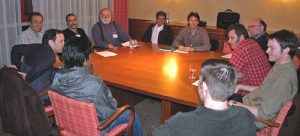EMBL-EBI Press Office
Wellcome Genome Campus Hinxton, Cambridgeshire CB10 1SD, UK
media@ebi.ac.uk+44 1223 494369

In the December 6 issue of Nature Biotechnology, scientists from 14 different organizations around the world, including the EMBL-European Bioinformatics Institute, propose a new quality standard for biochemical models. MIRIAM [for Minimum information requested in the annotation of biochemical models] will help researchers to reuse, modify and combine computer models of biochemical processes to gain a fuller understanding of life at the molecular and cellular level.
Biologists are making a concerted effort to catalogue all the molecular components of living things, from the smallest molecules and ions to the genetic code. These ‘parts lists’ help them to build computer models that simulate living processes. By combining models of simple processes they hope to understand and faithfully represent how entire biological systems – be they cells, organs, organisms or ecological niches – work. As well as contributing to the understanding of biology, this approach has numerous applications: for example, diseases can be simulated, and treatment regimens optimised.
“The computational systems biology community has made enormous progress in improving access to models,” explains the EMBL-EBI’s Nicolas Le Novère, lead author of the paper. “We’ve begun to share programming languages for encoding them [e.g. systems biology markup language, www.sbml.org] and to build public repositories so we can share them [e.g. www.ebi.ac.uk/biomodels]. The current challenge is quality control: systems biologists won’t use publicly available models if they can’t search them properly, of if a model’s reuse is hampered by a tiny mistake in the way that it’s encoded. MIRIAM is an attempt to address these issues.”
MIRIAM has two parts: [1] a set of checks that match a model to its description [‘reference correspondence’, often a publication in a scientific journal], and [2] a set of ‘annotation schemes’. The first of these documents the model’s provenance: who created it, whether it’s been modified, and a stable link to its full description; the second scheme links the components of the model to relevant bioinformatics resources: for example, a model of alcohol metabolism in the liver would be annotated with links to the protein databases for all the enzymes involved in this pathway, and database links to all the relevant metabolites. The aim of these annotation schemes is to make it easier for researchers to search models on the basis of their components, to contact the creators of the model if they need more information, and to track the history of a model if it has been modified.
MIRIAM’s creators include representatives of four major repositories for models [BioModels Database, CellML Model Repository, DOQCS and SigPath], all of which are now in the process of making the models in their repositories MIRIAM compliant. “By adopting MIRIAM as a voluntary code of conduct, we will be able to provide our users with a reasonable level of quality assurance, so they’ll be able to get on with the business of generating and testing new hypotheses instead of recoding someone else’s old hypothesis,” continues Le Novère. “We also hope that journal editors will adopt MIRIAM as a quality control measure for papers that describe models. This approach has worked very well for other fields – for example the microarray community, by enabling authors, publishers and data providers to work together to improve access to meaningful biological information.”
Looking for past print editions of EMBLetc.? Browse our archive, going back 20 years.
EMBLetc. archive